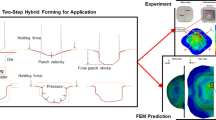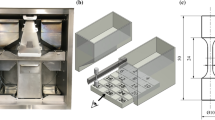Abstract
The physically based constitutive modeling, simulation and experimental of a superplastic forming and diffusion bonding (SPF/DB) process were studied for the manufacture of a pyramid lattice Ti-6Al-4 V sandwich panel structure. The high-temperature deformation behaviors of Ti-6Al-4 V were studied using uniaxial tensile tests at various temperatures 860 – 950 °C and strain rates 0.0001 s−1 ~ 0.01 s−1, corresponding microstructures were observed using optical microscope (OM) and Electron Backscattered Diffraction (EBSD). Based on obtained flow behavior and microstructure, a set of physically based constitutive equations of the Ti-6Al-4 V was established and used to simulate the superplastic forming for a pyramid lattice sandwich panel. The thinning ratios, dislocation densities, grain sizes and damage distributions of the sandwich panels were successfully predicted by the finite element (FE) simulation. A pyramid lattice Ti-6Al-4 V alloy sandwich panel with good dimensional accuracy and mechanical properties was manufactured by the SPF/DB process at 920 °C with a gas loading path of 0.0005 MPa/s. The maximum thickness thinning ratio, damage factor and relative grain size at the ribs of the sandwich panel were 26.3%, 6.7% and 0.94, respectively. The established constitutive model aids the FE simulations of SPF/DB manufacture of sandwich panels’ structure enabling both macro- and micro-properties to be synergistically controlled and guides the practical process optimizations.




















Similar content being viewed by others
References
Banhart J. Manufacture, characterisation and application of cellular metals and metal foams. Prog Mater Sci. 2001;46(6):559–632.
Evans AG, Hutchinson JW, Fleck NA, et al. The topological design of multifunctional cellular metals. Prog Mater Sci. 2001;46(3):309–27.
Kim T, Hodson HP, Lu TJ. Fluid-flow and endwall heat-transfer characteristics of an ultralight lattice-frame material. Int J Heat Mass Transf. 2004;47(6–7):1129–40.
Lu TJ, Hess A, Ashby M. Sound absorption in metallic foams. J Appl Phys. 1999;85(11):7528–39.
Xue Z, Hutchinson JW. Preliminary assessment of sandwich plates subject to blast loads. Int J Mech Sci. 2003;45(4):687–705.
Park K, Lee S, Kim C, et al. Fabrication and electromagnetic characteristics of electromagnetic wave absorbing sandwich structures. Compos Sci Technol. 2006;66(3):576–84.
Wieding J, Jonitz A, Bader R. The effect of structural design on mechanical properties and cellular response of additive manufactured titanium scaffolds. Materials. 2012;5(8):1336–47.
Liu Z, Chen H, Xing S. Mechanical performances of metal-polymer sandwich structures with 3D-printed lattice cores subjected to bending load. Arch Civil Mech Eng. 2020;20(3):89.
Wadley HNG. Multifunctional periodic cellular metals. Philos Trans. 1838;2006(364):31–68.
Kooistra G. Compressive behavior of age hardenable tetrahedral lattice truss structures made from aluminium. Acta Mater. 2004;52(14):4229–37.
Tan Z, Bai L, Bai B, et al. Fabrication of lattice truss structures by novel super-plastic forming and diffusion bonding process in a titanium alloy. Mater Des. 2016;92:724–30.
Boyer R R, Froes F H S, Chen E Y. High performance metallic materials for cost-sensitive applications. Pennsylvania, America: A Publication of The Minerals, Metals & Materials Society. 2013.
Xun YW, Tan MJ. Applications of superplastic forming and diffusion bonding to hollow engine blades. J Mater Process Technol. 2000;99(1):80–5.
Li ZQ, Guo P. Application progress and development trendency of superplastic forming / diffusion bonding technology. Aviation Manufact Technol. 2010;08:32–5.
Barnes AJ. Superplastic forming 40 years and still growing. J Mater Eng Perform. 2007;16(4):440–54.
Derby B, Wallach ER. Joining methods in space: a theoretical model for diffusion bonding. Acta Astronaut. 1979;7(4–5):685–98.
Han W, Zhang K, Wang G. Superplastic forming and diffusion bonding for honeycomb structure of Ti–6Al–4V alloy. J Mater Process Technol. 2007;183(2–3):450–4.
Lin J. Selection of material models for predicting necking in superplastic forming. Int J Plast. 2003;19(4):469–81.
Lin J, Cheong BH, Yao X. Universal multi-objective function for optimising superplastic-damage constitutive equations. J Mater Process Technol. 2002;125–126:199–205.
Yang L, Wang B, Liu G, et al. Behavior and modeling of flow softening and ductile damage evolution in hot forming of TA15 alloy sheets. Mater Des. 2015;85:135–48.
Yasmeen T, Shao Z, Zhao L, et al. Constitutive modeling for the simulation of the superplastic forming of TA15 titanium alloy. Int J Mech Sci. 2019;164:105178.
Bai Q, Lin J, Dean TA, et al. Modelling of dominant softening mechanisms for Ti-6Al-4V in steady state hot forming conditions. Mater Sci Eng A. 2013;559:352–8.
Alabort E, Putman D, Reed RC. Superplasticity in Ti–6Al–4V: characterisation, modelling and applications. Acta Mater. 2015;95:428–42.
Zhang QC, Han YJ, Chen CQ. X-type ultralight lattice structure core (I): concept, material preparation and experiment. Chin Sci. 2009;39(06):1039–46.
Wang J, Evans AG, Dharmasena K, et al. On the performance of truss panels with Kagomé cores. Int J Solids Struct. 2003;40(25):6981–8.
Calamaz M, Coupard D, Girot F. A new material model for 2D numerical simulation of serrated chip formation when machining titanium alloy Ti–6Al–4V. Int J Mach Tools Manuf. 2008;48(3):275–88.
Liu Z, Wang X, Jiao X, et al. Prediction of microstructure evolution during hot gas forming of Ti2AlNb-based alloy tubular component with square cross-section. Proc Manufact. 2018;15:1156–63.
Mukherjee AK. An examination of the constitutive equation for elevated temperature plasticity. Mater Sci Eng. 2002;322(1–2):1–22.
Avrami M. Granulation, phase change, and microstructure kinetics of phase change. J Chem Phys. 1941;9(2):177–84.
Garrett R, Lin J, Dean T. An investigation of the effects of solution heat treatment on mechanical properties for AA 6xxx alloys: experimentation and modelling. Int J Plast. 2005;21(8):1640–57.
Lin J. Fundamentals of materials modelling for metals processing technologies: theories and applications. Imperial College Press. 2015;2015:1–512.
Wu Y, Wang D, Liu Z, et al. A unified internal state variable material model for Ti2AlNb-alloy and its applications in hot gas forming. Int J Mech Sci. 2019;164:105126.
Ma ZY, Mishra RS. Cavitation in superplastic 7075Al alloys prepared via friction stir processing. Acta Mater. 2003;51(12):3551–69.
Piekło J, Małysza M, Dańko R. Modelling of the material destruction of vertically arranged honeycomb cellular structure. Arch Civil Mech Eng. 2018;18(4):1300–8.
Li J, Wang B, Huang H, et al. Behaviour and constitutive modelling of ductile damage of Ti-6Al-1.5Cr-2.5Mo-0.5Fe-0.3Si alloy under hot tensile deformation. J Alloys Compd. 2019;780:284–92.
Acknowledgements
The authors gratefully acknowledge the financial support from the National Natural Science Foundation of China under Grant No. 51805256.
Funding
This research was jointly supported by National Natural Science Foundations of China under Grant No. 51805256.
Author information
Authors and Affiliations
Corresponding author
Ethics declarations
Conflict of interest
The authors declare that they have no known competing financial interests or personal relationships that could have appeared to influence the work reported in this paper.
Ethical approval
This article does not contain any studies with human participants or animals performed by any of the authors.
Additional information
Publisher's Note
Springer Nature remains neutral with regard to jurisdictional claims in published maps and institutional affiliations.
Rights and permissions
About this article
Cite this article
Wu, Y., Wu, D., Ma, J. et al. A physically based constitutive model of Ti-6Al-4 V and application in the SPF/DB process for a pyramid lattice sandwich panel. Archiv.Civ.Mech.Eng 21, 106 (2021). https://doi.org/10.1007/s43452-021-00260-0
Received:
Revised:
Accepted:
Published:
DOI: https://doi.org/10.1007/s43452-021-00260-0




